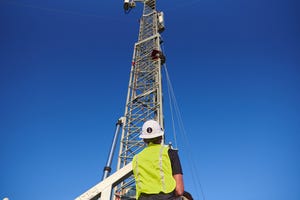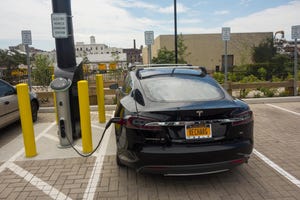Mobile Telecom – Leading and Enabling the Path to Net Zero
Steep cuts in emissions required to combat climate change. #sponsored

According to Gallup's annual Environment poll, 60% of US adults believe the effects of global warming have already begun, while 45% think it will pose a serious threat to their way of life during their lifetime. From wildfires in California to ice storms in Texas and hurricanes on the eastern seaboard, extreme weather events appear to be occurring more regularly and causing more damage. And not just in the US, of course.
The concerns over global warming have led nations around the world to commit to reductions in their CO2 emissions by weaning their economies off of fossil fuels. Under pressure from regulators, customers, and investors, companies are acting now to reduce their carbon footprint.
The Science-Based Pathway to Net Zero for the ICT industry (as defined by the SBTi) requires mobile network operators to slash operational emissions by 45% between 2020 and 2030. Over the same period, fixed network operators must reduce their emissions by 62%, and data centers by 53%. To discuss how operators are going to meet these targets while upgrading to the latest technology, Ericsson recently held a roundtable, “Building efficient 5G networks—the journey to Net Zero emissions”, with the participation of GSMA Intelligence and Omdia.
Network modernization is key to energy saving
The telecom industry consumes around 1% of global electricity. For mobile operators most of the electricity is consumed by the radio access network. “That is why there is such a focus on energy efficiency as mobile operators upgrade to 5G because that is where the greatest gains are available,” noted Tim Hatt, head of Research and Consulting at GSMA Intelligence.
Network modernization is indeed one of the key things that MNOs can do to reduce their carbon emissions. For example, AT&T has said that its adoption of NFV has allowed it to reduce unused capacity and unnecessary energy consumption. With NFV, AT&T is replacing energy-hungry network equipment with energy-efficient hardware that runs virtualized network functions.
Verizon has seen similar reductions in its carbon intensity by moving from older technologies to more energy-efficient ones. Shutting down legacy networks and technology (such as 3G) and moving from copper to fiber optics for fixed line access are just some of the ways that operators are reducing their energy consumption.
The adoption of 5G will also play a key role. According to Paul Challoner, VP of Network Product Solutions at Ericsson, 5G is currently about 40% more energy efficient than 4G. “But in the long run once all the energy efficiency features are implemented 5G should be 10 times more efficient than 4G,” said Challoner. Those gains are a combination of more efficient hardware (e.g., power amplifiers) and more intelligent software that, for example, enables greater use of sleep mode for radio transmitters at night. “The network is dimensioned for the busiest hour of the day,” explains Challoner, “by using AI, operators can predict the usage of the network more accurately allowing them to maximize the sleep mode windows that can be safely used without impacting performance”.
Predictive analytics can also help reduce the need for operational tasks and the associated energy consumption. “We can reduce the number of site visits that are required in a cellular network thereby reducing the number of truck rolls and the fuel consumption of field engineer vehicles,” stated Challoner.
New cell sites are also more energy efficient by design. For example, they no longer need enclosures with air conditioning. Instead, the base station equipment can be housed in a cabinet that is located outdoors and has built-in convection cooling. And with more precise RAN planning, operators can enjoy greater energy efficiency by using fewer cell sites.
But it’s not all just about adopting new technology. A successful energy saving strategy requires access to the right information. Operators often suffer from poor visibility into which elements in their networks are the most power hungry. By closely monitoring the energy consumption of active and passive systems operators can more easily identify which elements are the most power hungry and hence where the greatest energy-saving opportunities lie.
The ICT Industry’s Enablement Factor
While it is important that telecom operators improve their own energy efficiency, we should also consider how the ICT industry can enable society at large to be more energy efficient. Various studies have modelled CO2 abatement factors with a typical estimate around 10. That means that for every ton of CO2 equivalent emissions that the ICT industry generates, around 10 tons are saved elsewhere in the economy.
These savings arise from dematerialization (e.g., replacing paper-based systems with electronic documents), demobilization (e.g., replacing the daily commute with teleworking), and decarbonization. This last term is a catch all for energy efficiency gains that come from making traditional industries and activities smarter. For example, smart manufacturing, drone-assisted agriculture, or IoT-sensor enabled buildings.
According to Hatt, “One of our recent studies looked at manufacturing, energy, buildings, and transportation which collectively comprise around 80% of global CO2 emissions. We estimate that around 40% of the CO2 reductions that these industries need to make in the next decade can come from technology, much of which is mobile-related”.
Ericsson has observed similar benefits at its own 5G factory in Lewisville, Texas. This 300,000 square foot facility has over 200 robots in operation and cost $100m to build. The factory’s integrated environmental systems are designed to reduce energy consumption by 24 percent and indoor water usage by 75 percent. It runs on 100 percent renewable electricity, some of which is generated by the site’s own solar panels.
The factory has been recognized by the World Economic Forum as a “Global Lighthouse,” one of the world’s most advanced sites implementing technologies of the Fourth Industrial Revolution. Employee productivity at the factory is more than double that of Ericsson’s conventional factories. “Every aspect of sustainability and automation has been considered. We see it as a blueprint that could be taken to factories in other industries,” notes Challoner.
Hatt agrees, “We need to show to industry verticals the productivity gains and energy savings that can be enabled though mobile connectivity solutions. For example, smart factories that are fitted with IoT sensors have seen significant productivity gains. That feeds directly through to the bottom line so makes sense financially as well as from an environmental perspective.”
The nexus of the economy
Telecoms is leading many other industries on the path to net zero. For example, AT&T and Verizon are targeting to become carbon neutral for operational emissions (scope 1 and 2) by 2035. In 2021 T-Mobile USA sourced 100% of its electricity from renewable sources, up from 25% the prior year. Telecom operators are also enabling other industries to reduce their emissions.
“The ICT industry sits at the nexus of the economy,” notes Hatt. “Telcos can help other industries lower their carbon footprints through advanced technology, including 5G. There is a huge enablement effect to leverage that can help digitize and decarbonize the economy.”
Enabling the broader economy to meet its sustainability goals is something the telecom industry should feel proud of. As Challoner observed, “Reaching net zero is something that we all must do as good corporate citizens. Tough choices will need to be made but I believe it is something that simply hast to happen for the wellbeing of the planet.”
A replay of the roundtable discussion can be accessed here.
— James Crawshaw, Principal Analyst, Service Provider Operations & IT, Omdia
Read more about:
OmdiaAbout the Author(s)
You May Also Like












